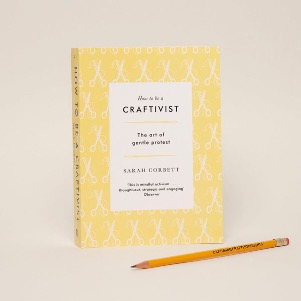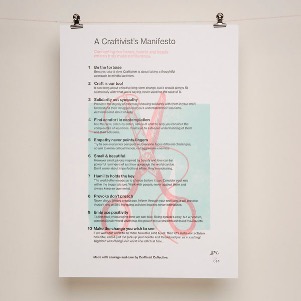This text is licensed under the Creative Commons license Attribution-NonCommercial-ShareAlike 4.0 International. The link to the original material is situated at the top right of the text.

How to be a craftivist. The art of gentle protest
Sarah Corbett
2017
Keywords: counterexample, decontextualization
Threads: Inquiring
Short description
This book is dedicated to “everyone who wants to help improve our wonderful world in a beautiful, gentle and loving way”. Its author is also the founder (in 2009) of Craftivist collective, a social enterprise developing projects where messages are stitched in small objects (“solidarity bunting”, banners, hanky, stitchable portraits of “changemakers” like Desmond Tutu, Eleanor Roosevelt or Abraham Lincoln, with inspiring quotes, etc.).
The book contents four parts: Definitions (of craftivism and gentle protest); Power in the process; Power in the product; Power in the public sphere.
Focusing only on her own embroidery practice and projects (and not on other practices that could be called “craftivist”, like yarn bombing, political clothing making, local female-led enterprise, and other historically and geographically situated “craftivisms”), Corbett gives various kind of advice for those who want efficient tools to fight any kind of “injustice and atrocities”. The book focusses more on the craftivists well-being, needs to feel valued, etc. than on the injustices in question.
Personal appreciation
The word “craftivism” is very appealing in the SHAKIN’ context, as it seems to shed light on marginalized, invisibilized, most often feminine practices, and help understand how they are political in themself (depending on the way we look at them) and/or how the craft practices and productions can be used for the empowerment of groups or communities.
It turns out that the book does not grasp the word “craftivism” this way; on the contrary, it describes a rather professional, strategical and efficient way of doing activist campaigns, for people who are able to identify and collaborate with cultural institutions, enterprises, political representatives, etc. – or for people who want to engage as a hobby. The focus is put on individuals (participants of the craftivism workshop and target audiences), their feelings, their susceptibility, sometimes with the help of (neuro)psychology, neurosciences, cognition, etc.
Corbett’s craftivism is then interesting for me as it allows to clearly identify what sharing subaltern knowledge through cultural cooperation is not.
Contribution to the "Who knows?" handbook
Corbett’s craftivism draws attention to important elements that we can agree on within SHAKIN’: the slow time required to produce small objects, and the interest to reduce the pace; the political, emotional, situated strength that tangible, small, daily objects can have; the importance of processes (of thought, of making), which can overcome the result itself.
Nevertheless, Corbett’s craftivism is primarily a counterexample for us. Sometimes it is easier to identify what we want to implement, or ways of doing things, by looking at proposals where these requirements are not present – not least because the cooperations we are interested in cannot be describe in general, universal way.
Which requirements are lacking here?
First, causes are interchangeable: they are generally described as “injustices”, not historically anchored, and are most often not of direct concern for the workshop participants which are asked to show their solidarity. The positionality (see this entry) of the participants is never questioned.
Second, the focus is put on the needs of the participants (feeling valued, being comfortable, etc.) rather than the need of those affected by the injustice.
Third, except for a one-paragraph stand about the link between craft and overlooked female activity, the craft in question (embroidery) is described as a hobby, accessible for everyone, without questioning its roots, its local histories, the kind of knowledge it carries, etc. In Corbett’s craftivism, embroidery allows to break the ice within a group of beginners, and helps produce objects which are pleasant, not frightening, etc.
And finally, Corbett gives a list of recipes, “how-to”, feel-good thoughts, practical advice etc.: the craftivism toolbox is easily replicable, because it does not explicitly depend on a context – it could then contribute to replicate unthought structures of domination, rather than empowering and giving a voice the victims of “injustices”.
Material(s)
Link to material #2 - Daniel Fountain, “Survival of the Knittest: Craft and Queer-Feminist Worldmaking”, MAI: feminism & visual culture n° 8, December 2021
Additional Information
| Location | United Kingdom |
| Original language(s) | English |
| Existing translations | |
| Length | 305 pages |
| Project runtime | 2009 - |
| Institution of affiliation | |
| Sponsor(s) |
Additional Pictures

Creative Commons
Related Contributions

CRAFTpedia
Project ARTCademy – University of Malaga, AGH Faculty of Management, Andalucía Emprende, Asociatia Edunet Organization Romania, Organization for Promotion of European Issues (OPEI), Comenius University, Internet Web Solutions, IHF, Institut de Haute Formation aux Politiques Communautaires asbl, IDP SAS
2018
the craftpedia presents very diverse crafts and practices, from more popular ones to very specific, place-based or endangered ones.







